Deze blog bevat affiliatelinks. Lees hier meer over wat affiliatelinks zijn en waarom ik ze gebruik.
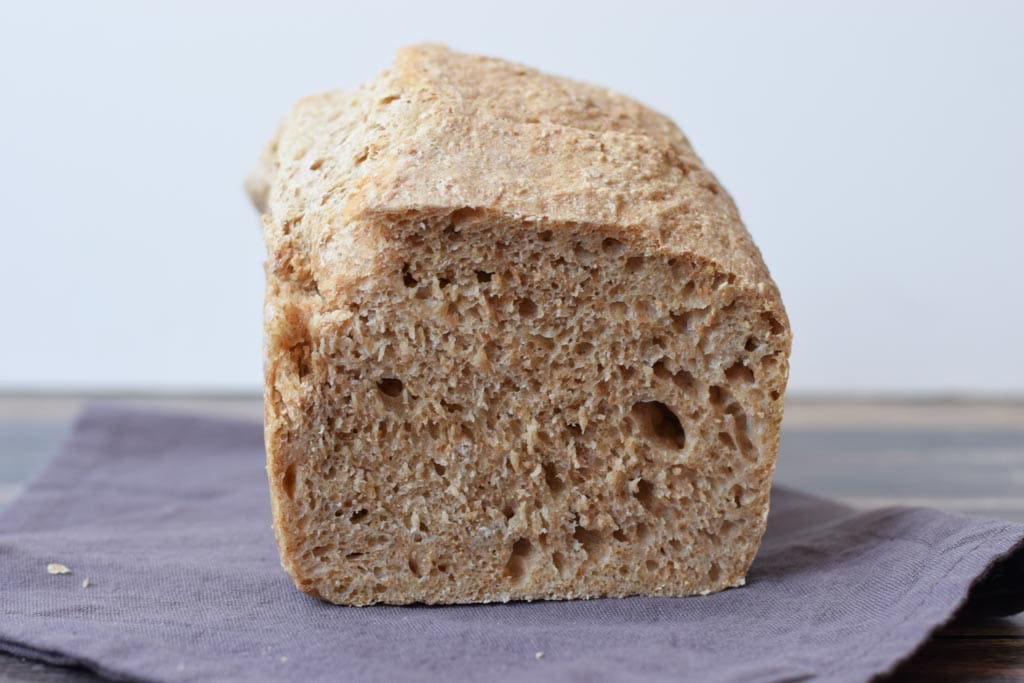
Making sourdough spelt bread with a sourdough starter
Latest update: may 2019
I have wanted to make my own sourdough bread for ages, but the long process of making a sourdough starter kept me from it.
When I found a simply explained recipe on the Dutch website walrabenstein.nl, I decided to try it.
I was a bit skeptical about the chance of success on the first try, but I managed! After a process of a week, I had yummy sourdough spelt bread!
For people who have IBS, sourdough spelt bread can be a good replacement for normal bread. Wheat and bread made from wheat contain fructans (one of the FODMAP groups) and are high FODMAP (only in small amounts of wheat is low FODMAP).
Spelt contains fewer fructans than wheat but is still high in FODMAPs. There are, however, quite a lot of people with IBS who tolerate spelt well, so it is definitely worth testing how you react to it.
Next to that, when spelt is processed in certain ways it can become lower in FODMAPs (read my blog about FODMAPs & spelt for more info). One of these “processes” is the sourdough process.
According to Monash University, sourdough spelt bread is low FODMAP up to 2 slices per serving and also sourdough bread made from wheat is low FODMAP up to 2 slices per serving. See the Monash University app for more information.
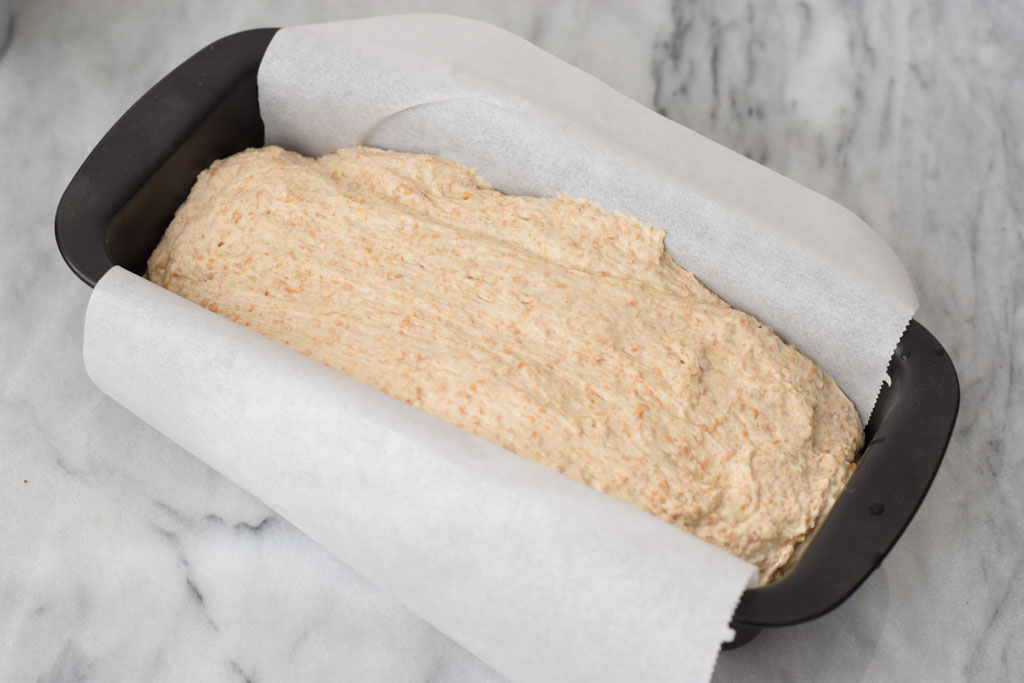
Does sourdough spelt bread really taste sour?
I think sourdough bread has a light sour taste, but it is not too noticeable. Sourdough bread definitely tastes different than bread made with yeast, but I personally really like it.
When I compare sourdough bread with the bread that I used to eat when I could still tolerate wheat, I think this has so much more flavour and it is also more filling.
After two slices of sourdough spelt bread, I feel full, while I could easily eat 4 slices of wheat bread in a row. I must admit that we used to eat relatively cheap bread from the supermarket.
So I think that is not comparable with high-quality wheat bread from the bakery. Higher-quality wheat bread probably fills you up better too.
You might have to get used to the flavor of sourdough spelt bread a little, but after a while you won’t want anything different! I
f you fell in love with it, like I did, definitely give my recipe for sourdough spelt bagels a try too or make a delicious sourdough grilled toast sandwich.
Print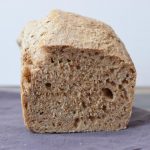
Making sourdough spelt bread with a sourdough starter
- Total Time: 6 days 30 min
- Servings: 1 bread 1x
Description
Homemade sourdough spelt bread with a sourdough starter. This recipe does not contain yeast and is low FODMAP. You only need spelt flour, water and salt.
Ingredients
- A glass jar or bowl that can contain about a liter (4 1/2 cups)
- 300 gram (2 cups + 1 tbsp) white spelt flour
- 500 gram (3 1/2 cup) wholemeal spelt flour
- 2 tsp salt
- Water
Instructions
- The process takes about a week. It is important that you stir the sourdough starter every day in the morning and in the evening and if possible also once during the day.
- Day 1: Mix 100 g (2/3 cup + 1 tbsp) spelt flour and 100 ml (1/3 cup + 1 tbsp) lukewarm water in the jar/bowl. Mix it until it is a smooth mixture. Put the bowl in the kitchen with a damp tea towel over it.
- Day 2 and 3: Stir the mixture through in the morning and in the evening (and during the day if possible).
- Day 4: At this point, you should see some air bubbles in the mixture and it smells a bit sour. If this is not the case it is possible that the process takes a little longer, you can just continue with the process for about 2 more days. It is also possible that the mixture smells really sour and bad, then it has gone wrong and you have to start over, unfortunately.
- You can now feed your sourdough (it is like a baby :)). Add 100 g (2/3 cup + 1 tbsp) spelt flour and 100 ml (1/3 cup + 1 tbsp) lukewarm water to the bowl and stir it through well. Put the bowl away again with the damp towel over it and also stir it through in the evening.
- Day 5 – morning: If all is well, the desem is quite active now. You can feed it one more time. Add 100 g (2/3 cup + 1 tbsp) spelt flour and 100 ml (1/3 cup + 1 tbsp) lukewarm water again. After feeding, you need to leave the starter for about 8 hours. If you feed your starter in the morning on day 5, you can make the dough in the evening and bake your bread the next morning.
- Day 5 – evening (at least 8 hours after the last feed): you can now make the dough for your bread. Put 500 gram (3 1/2 cup) wholemeal spelt flour with the salt in a bowl and make a dent in the middle. Add 350 gram (12.35 ounces or 3/4 pound) of the starter. Then add 200-350 ml water (about 3/4 cup to 1 1/2 cup). It differs per starter how much water you need, so start with 2oo ml (3/4 cup) and add some more if the dough is too dry.
- Knead the dough until you have an elastic dough ball. Put the dough in a bowl and put a damp towel on top. Leave the dough to rise overnight.
- Day 6: layer a 26 cm (1o inch) cake or bread tin with baking parchment. Knead the dough one more time (otherwise you will get air bubbles in your bread) and put it into the baking tin. Put a damp towel over it again and leave it to rise for another 2 hours until the dough has almost doubled. If it hasn’t risen enough after two hours, you can leave it for 2 hours longer.
- Pre-heat the oven to 230 degrees Celsius (450 F). Put the bread into the oven and spray some water into the oven with a spray bottle. This gives a steam effect and will help to give the bread a crunchy crust.
- Put the timer of the oven to 30 minutes. Lower the temperature to 200 degrees Celsius (390 F) after 5 minutes of baking. When the bread has 15 minutes left in the oven, lower the temperature to 170 degrees Celsius (340 F).
- Take the bread out of the oven and knock to see if it is done. Leave the bread to cool down completely before you cut it.
Notes
You can store the bread for several days into a closed box or bag. You can also freeze it.
Sometimes your starter is not active enough at day 4. Then you can just wait for two more days and repeat the steps from day 2 and 3: stirring the starter through in the morning and evening. As long as the mixture doesn’t smell or look bad, that is no problem.
You can use the starter that you have leftover after baking the bread to make a new starter. Simply start feeding it again with an equal amount of water and flour. I usually do 50 ml water (3 tbsp) and 50 g flour (1/3 cup)
Storing the starter: you can store the starter at room temperature, if you want to bake with it several times per day. Simply feed your starter an equal amount of water and flour, like in the note above, and stir well. Like this, your starter will remain active. If you want to bake less often, you can also store the starter in the fridge. You only have to feed it once per week then. If you want to use your starter again, you can take it out of the fridge. Feed it again and leave it to come to room temperature for a few hours. Your starter is ready to use when it is very bubbly and airy.
As noted in the recipe, I use white spelt flour for the starter and wholemeal spelt flour for the bread. This is the combination that I prefer. In the past, I have also made delicious breads with only wholemeal spelt flour (also for the starter), so you can try that too.
- Prep Time: 6 days
- Cook Time: 30 min
- Category: Baking
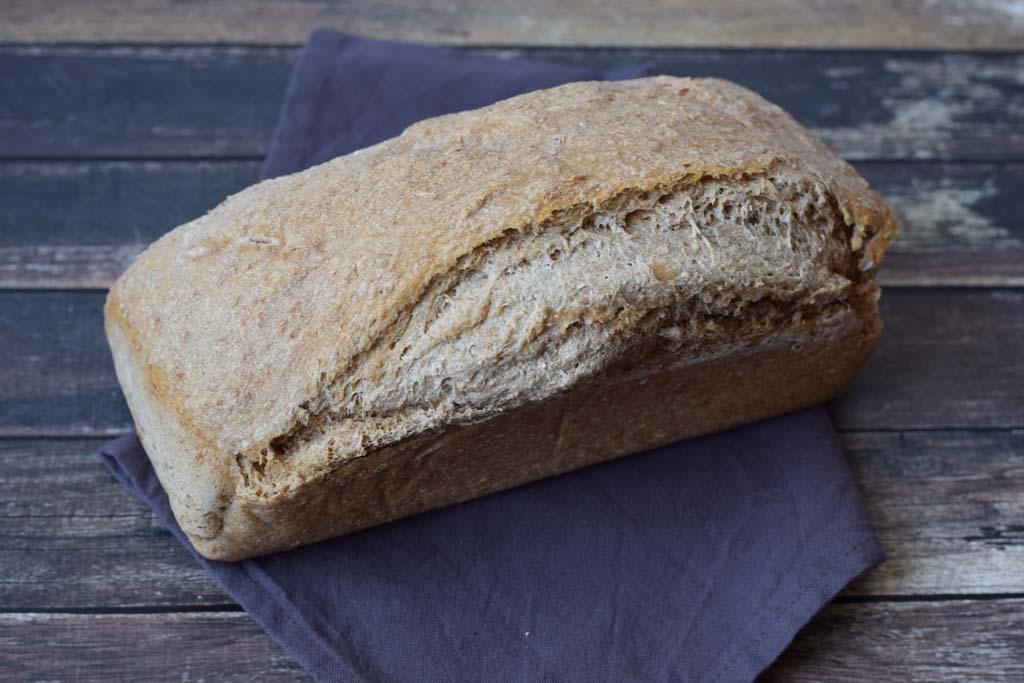
Together we go for a calm belly!
Subscribe to the Karlijn's Kitchen e-mail newsletter for more tips and recipes and receive the ebook 10 things I wish I had known when I started the FODMAP diet for free!
Laat je het me weten als je dit recept gemaakt hebt? Ik zou het heel leuk vinden als je me laat weten wat je van het recept vindt door hieronder een reactie en een rating achter te laten. Je kunt ook je creaties met me delen op Instagram door de hashtag #karlijnskitchen te gebruiken of door mij te taggen via @karlijnskitchen.

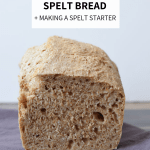
54 Comments
How much salt is needed?
2 tsp will do
Thanks so much for putting this recipe online. I made a loaf today and it tasted great. I adjusted the measurements as I only have a small loaf pan and it took three extra days to get my starter going as it’s cold in London right now but, other than that, it has worked a treat! Amy x
Great to hear! I am happy it worked out 🙂
Do I need to make a new starter for each loaf or can I just continue to feed the same one?
Is there a feeding schedule to keep it going long term?
You can continue to feed the same starter!
Do you feed the starter on a weekly basis after the first loaf? I have never done this before. Thanks
If you are planning to bake sourdough treats regularly. You can keep it on your kitchen counter and feed it every day. If you don’t bake that often, you can store it in the refrigerator and feed it once per week.
I find my spelt starter doesn’t rise that much, less than double on day 8. Is it still good to use as bread?
That is hard to say from a distance. If it looks bubbly enough, I would give it a try!
Thanks for this recipe! Do I need to store starter at a certain room temperature?
i have a question regarding the feeding amounts. Why is the feeding in 2 measurements? Add 100 g (2/3 cup + 1 tbsp) spelt flour and 100 ml (1/3 cup + 1 tbsp) again – i don’t understand this – i need more info. I really want to try this.
Hope to hear from you.
Because I had to convert 100 gram to cups and this is what the cup measurement voor 100 gram / 100 ml is. I am in the Netherlands and we work with grams and milliliters here, so I had to convert those amounts to cups 🙂
Thank you so much for this recipe, Karlijn,
I’ve never made sourdough before but now I have to consider a low FODMAP diet.
My first try led to a very heavy, dense loaf but my second try was a lot better … rose more and ended up being a lighter loaf. (I figured out I needed to let my sourdough starter age a day longer and then I needed to add a bit more water to the dough to make it slightly stickier.)
I quite love the taste of this and am so happy to have bread I can eat! I’m going to continue make it and perhaps finesse my sourdough making technique. 🙂
Happy to hear that!
thank you for this! i’m just about to start. i’m stumbling on step five, tho…when you say add
: Add 100 g (2/3 cup + 1 tbsp) spelt flour and 100 ml (1/3 cup + 1 tbsp) to the bowl and stir it through well.
is the second measurement, 100ml …that is a measurement for lukewarm water, yes? i’m almost sure it is but i just wanted make sure i understand! thanks so much!
Thank you for noticing Coco! That should say lukewarm water indeed. I have corrected it in the recipe now!
Thanks so much for this great post!
My question for you is I have organic spelt flour that was milled recently at a local farm. It does not say if it is white spelt or whole spelt, just “spelt flour.” Could I use this for all of the flour in the starter, do you think, or would it need to be blended with another flour?
That is fine to use!
Hi, I was just wondering how many cups 350 grams of the starter is?
I am not sure, I am in the Netherlands and we don’t use cup measurements here. I am working on converting my recipes so they have cup measurements too, but I haven’t managed to convert everything yet. As I don’t have a starter ready at the moment it is hard to measure that now 😉 I would advice just weighing the starter, so you can follow the gram measurements. It is also more accurate, which is quite important with baking 🙂
If anyone can let us know round about how much the 350 gm turned out to be in cups, please let us know 🙂 I’m in the initial stages and was so happy to find a recipe that used these measurements as I don’t have a scale as of yet. Thanks a bundle for posting this recipe.
How do you store the starter in the fridge? I left mine in a bowl with a damp cloth over. It didn’t look too good after about 5 days. I’ve been feeding it at room temperature for about a week now and it’s starting to come right (it had formed a crust and then the liquid had separated when I had it in the fridge). It still isn’t as lovely and bubbly as when I first made the starter so not sure what I did wrong. I’m down to one slice of bread in lockdown so I’ll try use it as it is and then hopefully will store it better than I did the first time round.
After you feed the starter, cover your bowl and leave it at room temperature for 2-3 hours, then put it back in the fridge to store.
Hi there Karlijn
I have tried to make this bread (my second attempt at sourdough although a different recipe) and it is not growing at all let alone doubling in size! I have followed the recipe precisely…. what could be Going wrong? Perhaps I need to keep it warmer. Our home is about 20 degrees centigrade. The smell of the starter was sour not bad and it had a few bubbles but not many.
Appreciate your tips
Thankyou
If it is not growing, it might indeed be that the temperature is a little low. Generally the best temperature is 20-25 degrees. So if you could put it in a spot that is slightly warmer this might work. I would just keep going for a bit because the starter might just need a little more time to get active.
Oh and also- is wholemeal the same as whole grain? I live in the US and haven’t really seen any spelt labeled as “wholemeal” so maybe that’s just a different way to say whole grain?
Yes, it is the same 🙂
I found your recipe very helpful. I started on day five as I already had a starter. I’m am amazed at how resilient the starter it is. By mistake I left it out for four days at room temperature, I’m in Newcastle so it’s winter. I just had to pour a little bit of alcohol liquid off, took about a cup Of starter and fed it and it worked a treat, risen in approx 4 hours.
My issue with making sourdough spelt has been that I take it out of the oven too quickly. I.e. it sounds hollow on the top but it’s still a little doughy inside. I felt that 30 minutes wasn’t long enough to bake this loaf, and that 50 minutes would’ve been more appropriate. This was in an electric oven.
Good to hear that! If the temperature is lower, it takes a bit longer for the starter to get active, so probably that’s why it wasn’t a problem that you left the starter out a bit longer.
In some ovens breads need a bit longer than in others, so if you feel like 50 minutes was better, definitely leave it in a bit longer next time!
Love the recipe! Just out of curiosity- is there a reason this sourdough bread is different than regular wheat sourdough? For instance, this is not done in a Dutch oven and doesn’t seem to be as fluffy/full of air bubbles as typical sourdough is. I was wondering whether you know why this is.
Thanks!!
I personally have no experience with making bread in a Dutch oven. Here in the Netherlands, using a Dutch oven is not so common, which is quite funny considering the name 😉 So that’s why I just bake it in the oven.
In my experience, not all sourdough has a lot of air bubbles. I think this might have something to do with the fact that it is a 100% spelt flour recipe and how fluffy a bread gets also differs per recipe. The 100% spelt bread that I get from my bakery here is for example a lot denser and heavier than the bread that I make with this recipe 🙂 So I think it really depends on the recipe
Hello, would this recipe work if I used a whole meal spelt starter and white spelt for the bread?
I think that would work!
Is there a way to make hamburger buns with this starter/recipe?
Thank you, Amy
I don’t have a recipe for that yet unfortunately! But maybe you could find a sourdough hamburger bun recipe and use this starter to make it with
Hi,
I measured 100g of spelt flour and added 100ml lukewarm water for day 1 – I got dough! Should it be a wet mix?
So want this to work lol!
Thanks heaps from Covid-lockdown in Melbourne, Australia
it should be a bit doughy, but not super dry. If you did the measurements correct, it should be oke 🙂
I measured exactly too, and got dough for the starter, – it looked like a cow pie. It did nothing but get dry over the first night. I am using sprouted spelt so will try again with slightly more water.. I hope that works!
Karlijn,
I had been making your low FODMAP spelt sourdough every week for about a year (and loving it) until I lost my starter during a lengthy power outage. (It’s a long story!!) I am now feeding a new starter which will be ready to use in a few days. Unfortunately, my schedule only allows for bread baking on weekends which can be frustrating if I’m out of bread during the week. My question is . . . has anyone ever used this recipe in a bread machine? I make lots of yeast breads for the rest of the family, and have 2 bread machines! If yes, please share the measurements and “baking” details.
My spelt is organic. I just read that organic flour has enzymes that will prevent the starter from working. If I use regular flour, for the starter, will this still be low FODMAP? I will search for non-organic spelt too.
Hi Karlijn,
I am new to FODMAP…and a bread lover. I just made the starter for sourdough using the metric measurements. Is it supposed to be thick like dough? I was unable to find white spelt flour, only organic and sprouted. Reading a previous comment on this site about organic spelt not fermenting, I chose to use the sprouted flour. I was also wondering if a bit my homemade kombucha would kickstart the process??
Thanks
It is quite thick, but not as thick as dough. It should be a little bit more liquid.
I am not sure if you could use kombucha, this is something I have never heard about.
Karlijn, I am so happy! My bread turned out amazingly well. I let the starter ferment an extra day as I like a really sour flavour. I think my flour might be extra dry, as the starter was quite firm to begin with. It loosened up once it started fermenting. Also, I had to add an extra 40 ml water, above your max measurement when making the dough. It was still elastic, barely sticking to my hands. So end result…it is so tasty!
Thank you so much for this recipe.
Nadine
I started the starter, yet after about 6 days, there were black mold spots on the the inside of my jar, which was new and thoroughly washed and dried beforehand. Did anyone else experience this? Was it due to the damp tea towel?
Many other recipes say to put a lid on loosely. What do you recommend? I had to throw it all away. Now, I am trying to begin again and have success. Thanks for any suggestions 🙂
Hello Karlijn, thank you for your lovely recipe, I found my dough a bit too sticky does that mean I need to add more water?
Lizzy
Hi there, I commenced making my stater yesterday and today the starter already smells a bit sour and is frothy and bubbly.
I live in a subtropical area in Australia and the climate is relatively warm and am wondering if the warmth has expedited it. I also started next to some sauerkraut I have fermenting.
Should I start feeding it now or just continue as per your instructions?
Hi there,
I am new to making sour dough. I have a question about the starter. I live in a a subtropical region of Australia. Yesterday I started my sourdough starter. This morning it was frothy, bubbly and smells sour and has risen in the bowl. it looks a pretty well like your description of day 4.
Do I feed it as per day 5 or should I continue to follow your recipe and not feed it yet. I am wondering if it has advanced due to the warm climate where I live, the days are currently about 28c and nights about 20c. I also have sauerkraut fermenting close by, could this also be a contributing factor?
Thanks for your recipe and looking forward to your reply.
Warm regards
Jo
I might have to try this out. Looking for new homemade bread recipe.
I have been looking for something like this recipe for 30 years!! I gave up! But when I found this I thanked the Dear Lord!! I’ve been very sick from a genetic condition gone haywire and was recommended the FODMAP diet once again. I remember my holistic Dr of years ago recommended spelt and no yeast! This is perfect!! Thank you and God bless!!
I am happy to hear that you like the recipe! I hope it will be helpful
Hi, thank you for your recipe. Can I ask why you don’t discard part of the starter? I see in other online recipes they do. My starter is not doubling in size. I think the weather has been too cold.
I am no sourdough expert, but as far as I know discarding the starter becomes important when you are keeping your starter for a longer period of time. To keep it healthy and growing. As I am creating a fresh starter in this recipe, I didn’t discard anything.
The weather can indeed play a role in this, the process might take a little longer if you can’t find a warmer spot to put your starter.
Hello, this is my second attempt at making spelt sourdough. Everytime I’ve cooked it, the top looks perfect but the bottom is doughy and the inside is doughy. Am I doing something wrong??